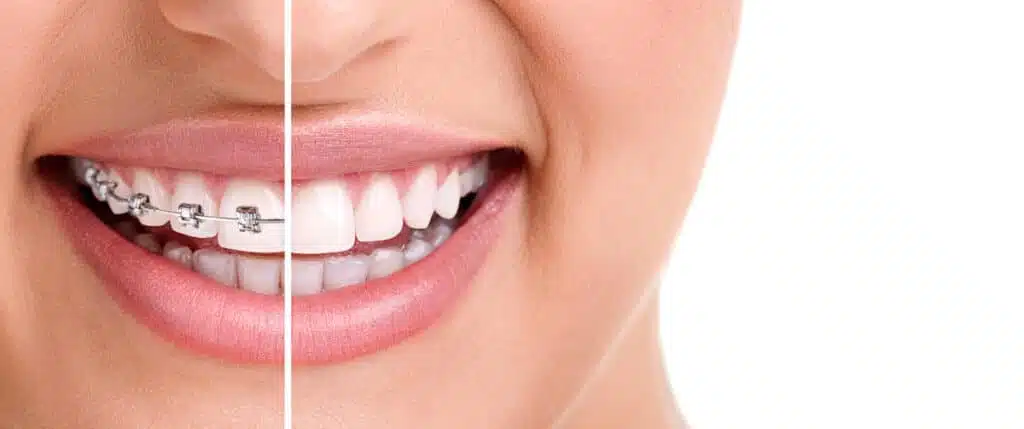Are Invisible Aligners cheaper than Braces? You’ll find the answer and all relevant information about the two types of orthodontic treatments in this article.
Are you considering orthodontic treatment to align your teeth but wondering about the cost?
The advancements in dental technology have given rise to alternatives like invisible aligners and traditional braces.
Both these options can help you achieve a straighter smile, but the cost factor plays a significant role in decision-making.
In this article, we will explore whether invisible aligners are cheaper than braces, comparing various aspects of both treatments.

Introduction to the Topic: “Are Invisible Aligners Cheaper than Braces?”
Orthodontic treatment aims to correct misaligned teeth and improve dental health.
Traditionally, braces have been the go-to solution for teeth straightening. However, invisible aligners have gained popularity in recent years due to their discreet appearance and convenience.
Let’s dive deeper into the world of invisible aligners and braces to understand their differences and determine their relative costs.
Understanding Invisible Aligners
Let’s start with some basic information about invisible aligners:
What are invisible aligners?
Invisible aligners, also known as clear aligners, are a modern alternative to traditional braces. They are custom-made, transparent trays made from smooth plastic.
These aligners gradually shift your teeth into the desired position over time, providing a nearly invisible treatment option.
How do invisible aligners work?
Invisible aligners work through a series of carefully designed aligner trays.
Each tray applies gentle pressure on specific teeth, gradually moving them into the desired alignment.
These trays are usually changed every two weeks to accommodate tooth movement progress.
Understanding Braces
Let’s continue with some basic information about traditional braces:
What are braces?
Braces are orthodontic appliances consisting of brackets, wires, and bands. The brackets are bonded to the teeth, and the wires are threaded through them.
By adjusting the tension of the wires, braces apply steady pressure to guide teeth into the correct position.
How do braces work?
Braces use a system of brackets, archwires, and elastics to align teeth. The brackets are attached to the teeth, and the archwire connects them.
Over time, the pressure from the archwire gradually shifts the teeth into the desired alignment.
Regular adjustments by an orthodontist are necessary to ensure progress and make any necessary changes.
Cost Comparison: Are Invisible Aligners Cheaper than Braces?
When comparing the costs of invisible aligners and braces, several factors come into play.
Factors influencing the cost:
The total cost of orthodontic treatment depends on various factors, including the case’s complexity, the treatment duration, the dentist’s experience, and the geographical location.
It’s essential to consult with an orthodontist who can provide an accurate estimate based on your specific needs.
Cost of invisible aligners:
The cost of invisible aligners typically includes the initial consultation, creating custom aligners, and periodic check-ups with your dentist or orthodontist.
While prices may vary, invisible aligners generally range from $1,500 to $7,000.
Cost of braces:
Braces generally involve the cost of the initial consultation, the brackets, wires, bands, and follow-up appointments for adjustments. On average, braces can cost between $2,500 and $6,000.
When considering costs, it’s crucial to factor in your dental insurance coverage, as some plans may partially cover orthodontic treatments.
Consulting with your insurance provider and orthodontist will help you determine the potential financial impact of either treatment option.

Effectiveness and Treatment Duration
Effectiveness of invisible aligners:
Invisible aligners are highly effective in treating mild to moderate teeth misalignment cases.
They can address issues such as overcrowding, gaps between teeth, and mild bite problems.
However, severe cases may require alternative treatments like braces or other orthodontic interventions.
Effectiveness of braces:
Braces are versatile and can effectively correct various teeth alignment issues, including moderate to severe cases.
They are particularly beneficial for complex cases that require significant tooth movement and jaw alignment.
Treatment duration comparison:
The treatment duration for invisible aligners and braces can vary depending on the case’s complexity. On average, invisible aligners may require 6 to 18 months for successful alignment, while braces can take approximately 18 to 36 months.
It’s important to discuss treatment timelines with your orthodontist to better understand the duration for your specific case.
Comfort and Convenience
The comfort of invisible aligners:
Invisible aligners are generally considered more comfortable than braces.
They are made from smooth plastic, without any protruding wires or brackets that may cause irritation or discomfort in the mouth.
However, some patients may experience temporary discomfort or soreness during the initial adjustment period with each new set of aligners.
The comfort of braces:
Braces can cause temporary discomfort due to the presence of brackets, wires, and bands.
The mouth may need time to adjust to the appliance, and occasional soreness or irritation may occur after adjustments.
Wax or orthodontic wax can be used to alleviate any discomfort caused by braces.
The convenience of invisible aligners:
Invisible aligners offer more convenience in terms of oral hygiene and dietary choices.
They can be easily removed for eating, brushing, and flossing, allowing you to maintain your regular oral care routine.
It’s important to wear aligners for the recommended number of hours each day to ensure optimal progress.
The convenience of braces:
Braces are fixed appliances that require extra attention to oral hygiene. Brushing and flossing can be more challenging due to wires and brackets.
Certain food restrictions may also apply to prevent damage to the braces. Regular visits to the orthodontist are necessary for adjustments and monitoring progress.

Aesthetics and Visibility
Aesthetics of invisible aligners:
One of the main advantages of invisible aligners is their discreet appearance. The aligner trays are transparent and blend with the natural color of your teeth, making them barely noticeable.
This aspect appeals to individuals who prefer a less noticeable orthodontic treatment option.
Aesthetics of braces:
Braces, on the other hand, are more noticeable due to the presence of brackets and wires on the teeth.
However, braces now come in various styles and colors, allowing individuals to express their personalities and make the treatment more enjoyable.
Visibility comparison:
In terms of visibility, invisible aligners are significantly less noticeable than braces.
This can particularly appeal to adults and teenagers who may feel self-conscious about wearing visible orthodontic appliances.
Maintenance and Oral Hygiene
Maintenance of invisible aligners:
Maintaining good oral hygiene with invisible aligners is relatively easy.
The aligners should be removed before eating, and the teeth should be brushed and flossed before reinserting.
Additionally, the aligners should be cleaned with a gentle brush and non-abrasive toothpaste to prevent bacterial growth.
Maintenance of braces:
Braces require extra attention to oral hygiene due to the presence of brackets and wires.
Specialized orthodontic brushes and flossing techniques are often recommended to ensure thorough cleaning.
Regular dental check-ups and professional cleanings are also important for maintaining oral health throughout treatment.
Oral hygiene considerations:
Proper oral hygiene is crucial for both treatment options to prevent tooth decay, gum disease, and other dental issues.
Neglecting oral hygiene can lead to complications and prolong the overall treatment duration.
Your orthodontist will provide detailed instructions on oral care specific to your chosen treatment.
Suitability and Treatment Options
Suitability of invisible aligners:
Invisible aligners are suitable for many cases, including mild to moderate teeth misalignments.
However, severe cases, complex bite issues, or significant jaw misalignments may require alternative treatment options such as braces or orthodontic surgery.
A consultation with an orthodontist will help determine the suitability of invisible aligners for your specific case.
Suitability of braces:
Braces are a versatile treatment option for various orthodontic issues, including mild to severe cases.
They can effectively address complex bite problems and significant teeth misalignments.
Your orthodontist will evaluate your dental condition and recommend the most suitable treatment.
Treatment options for different cases:
Depending on your specific case, your orthodontist may offer different treatment options.
They will consider factors such as your dental condition, treatment goals, and personal preferences to determine the best course of action.
It’s essential to thoroughly discuss with your orthodontist to make an informed decision.
FAQs on the Topic “Are Invisible Aligners Cheaper than Braces?”
In conclusion, when comparing the cost of invisible aligners and braces, invisible aligners tend to be slightly more expensive on average.
However, it’s crucial to consider other factors such as treatment duration, comfort, convenience, aesthetics, and oral hygiene maintenance.
Invisible aligners offer a discreet and convenient option for mild to moderate teeth misalignments, whereas braces are more suitable for complex cases and significant jaw misalignments.
Ultimately, the choice between invisible aligners and braces should be made in consultation with an experienced orthodontist, considering your specific dental needs and treatment goals.
Investing in orthodontic treatment is an investment in your oral health and overall well-being. With the guidance of a skilled orthodontist, you can achieve a confident smile that lasts a lifetime.

FAQs on the Topic “Are Invisible Aligners Cheaper than Braces?”
Are invisible aligners painful to wear?
No, invisible aligners are generally not painful to wear. However, some patients may experience temporary discomfort or soreness during the initial adjustment period with each new set of aligners. This discomfort is usually mild and subsides within a few days.
Can I eat normally with invisible aligners?
Invisible aligners should be removed before eating, allowing you to enjoy your meals without restrictions. This flexibility is one of the advantages of invisible aligners compared to braces. However, it’s important to brush your teeth before reinserting the aligners to maintain good oral hygiene.
Do braces work faster than invisible aligners?
In general, braces may require a longer treatment duration compared to invisible aligners. The exact treatment timeline depends on the complexity of the case and the desired outcome. Your orthodontist will provide a more accurate estimate based on your specific situation during the initial consultation.
Can invisible aligners correct severe misalignment?
Invisible aligners are effective for mild to moderate teeth misalignments. However, severe misalignments or complex bite issues may require alternative treatments such as braces or orthodontic surgery. It’s important to consult with an orthodontist to determine the most suitable treatment option for your specific case.
Do braces require more dental visits than invisible aligners?
Yes, braces generally require more frequent dental visits compared to invisible aligners. This is because braces require adjustments and monitoring by an orthodontist to ensure progress and make any necessary changes. Invisible aligners typically require fewer in-person visits, with periodic check-ups to monitor progress.
- About the Author
- More info


Leave a Reply